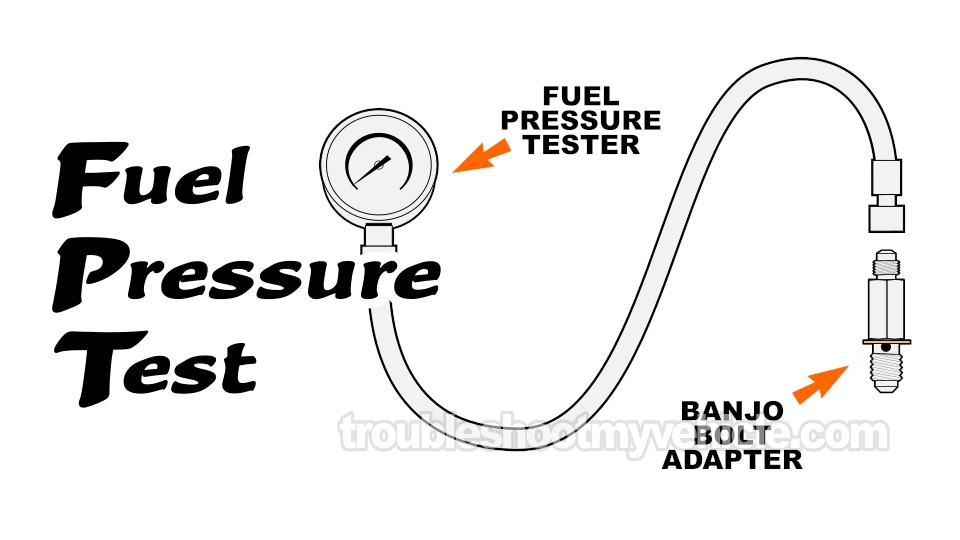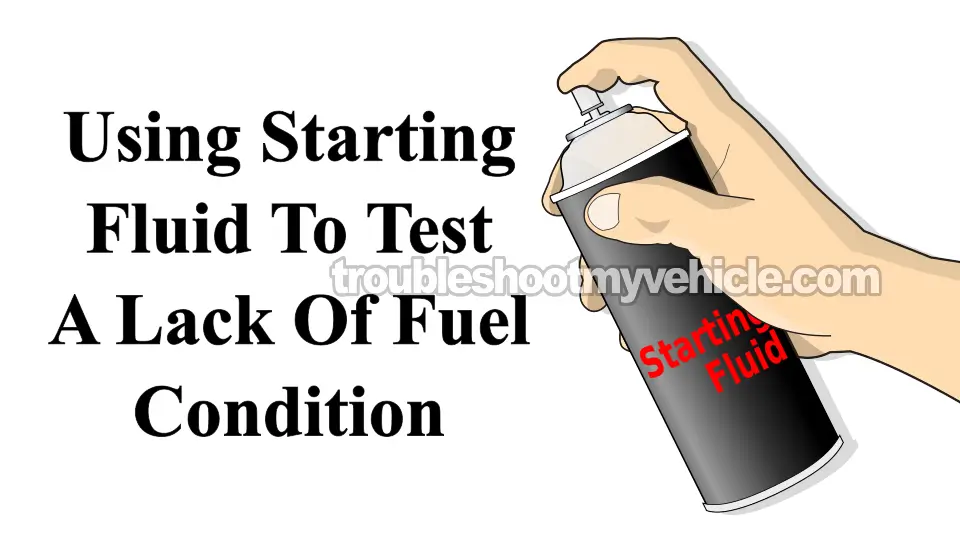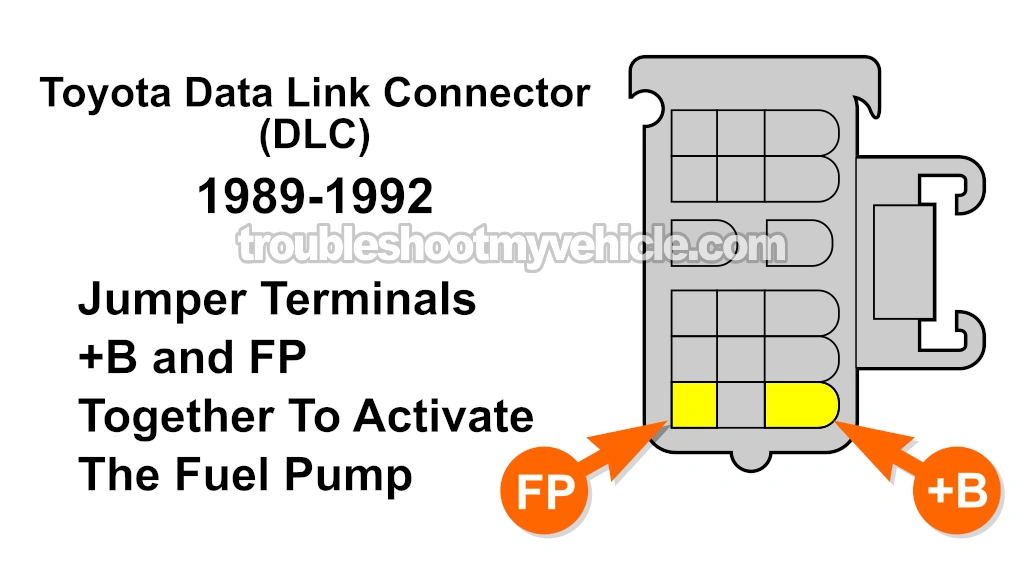
Checking the fuel pump on the 1989-1992 1.6L Toyota Corolla with a fuel pressure test gauge is easier than you'd think.
If your Corolla won't start or runs rough, and you think the fuel pump's the problem, the best way to know for sure is by testing it with a fuel pressure gauge.
In this guide, you'll learn how to connect the fuel pressure gauge, what readings you should see, and a quick troubleshooting test with starting fluid to see if a lack of fuel pressure is the reason your Corolla's engine won't start.
Contents of this tutorial:
APPLIES TO: This tutorial applies to the following vehicles:
- 1.6L (4A-FE) Toyota Corolla: 1989, 1990, 1991, 1992.
- 1.6L (4A-GE) Toyota Corolla: 1989, 1990, 1991.
- 1.6L Geo Prizm: 1990, 1991, 1992.
Engine No-Start Diagnostics:
Toyota Fuel Pump Test Tutorials:
- How To Test The Fuel Pump (1993-1996 1.6L Toyota Corolla).
- How To Test The Fuel Pump (1997 1.6L Toyota Corolla).
Wiring Diagrams:
- Fuel Pump Circuit Wiring Diagram (1989-1990 1.6L Toyota Corolla).
- Fuel Pump Circuit Wiring Diagram (1991 1.6L Toyota Corolla).
- Fuel Pump Circuit Wiring Diagram (1992 1.6L Toyota Corolla).
Symptoms Of A Bad Fuel Pump
Your Corolla's fuel pump will usually cause one of two issues when it fails:
- Engine no-start problem: This happens when it just stops working and nothing a replacement will get fuel back up to the engine.
- Engine performance problem: The fuel pump sends enough fuel to start the engine, but struggles to keep it running. Engine performance takes a hit —especially under load.
When the fuel pump completely gives out on your 1.6L Toyota Corolla, you'll see:
- You turn the key, the engine cranks, but it won't start.
- A spark test shows all cylinders are getting spark, so the ignition system's not the issue.
- A Noid light test proves the fuel injection computer's doing its job and firing the injectors.
- Your fuel pressure gauge reads zero, which means the pump's done for.
- If you spray starting fluid into the throttle body and crank it, the engine fires up —but only for a few seconds.
If your fuel pump is failing, but still allowing the engine to start, you'll notice some or all of these symptoms:
- Lean air/fuel mixture trouble codes pop up.
- Idle feels rough.
- Engine takes forever to start after cranking for a while.
- Acceleration feels weak when you're driving.
- Engine backfires through the intake manifold when you're pushing it under load.
A fuel pressure gauge can help you figure out if the fuel pump's causing the no-start issue or performance problems.
Where To Buy A Fuel Pressure Test Gauge
If you're diagnosing a no-start or engine performance issue, a fuel pressure test gauge is a must-have. You can pick one up at most auto parts stores or order one online.
These fuel pressure test gauge kits are solid deals, and they include the adapters you need for your 1.6L Toyota Corolla. Plus, they work for GM and Ford vehicles with Schrader valves too.
Disclosure: As an Amazon Associate, I earn from qualifying purchases. If my tutorials help you, using these links is an easy way to support the site at no extra cost to you. Thank you!
NOTE: All of the fuel pump pressure test kits above have the fitting that will connect to your Toyota's fuel system.
TEST 1: Checking Fuel Pressure With A Fuel Pressure Gauge
Like I said earlier, checking the fuel pressure is the best way to tell if your Toyota's fuel pump is failing or already dead.
You'll hook up the fuel pressure gauge to one of two locations:
- Directly on the cold start valve (fuel injector), which sits on the side of the intake manifold plenum (see photo above).
- Where the cold start valve supply line connects to the fuel rail.
To connect the gauge, just remove the fuel line union bolt (also called a banjo bolt) and swap it out with the gauge's adapter.
| Engine Off and DLC terminals +B and FP jumpered. |
|---|
| 38-44 PSI |
| Engine running and w/out vacuum hose connected to fuel pressure reg. |
|---|
| 38-44 PSI |
| Engine running and w/ vacuum hose connected to fuel pressure reg. |
|---|
| 1989-1992: 30-33 PSI |
| 1983: 31-37 PSI |
NOTE: If you don't have a fuel pressure gauge, take a look at the section: Where To Buy A Fuel Pressure Test Gauge.
Alright, let's jump into the test:
- 1
Put a shop towel under the cold start valve.
This towel will catch any fuel that might leak, drip, or spray when you loosen the cold start valve's banjo bolt (if there's still pressure in the fuel line). - 2
Take out the cold start valve's union bolt. The arrow in image 2 of 2 (above) points right at it.
NOTE: Be careful with the union bolt's two copper washers —they can easily fall into the engine bay. You'll need them when putting everything back together after the test.
IMPORTANT: When installing the adapter, you can place it either on the inlet side of the cold start valve line or directly on the cold start valve itself. However, do not remove the cold start valve or its supply line —they must stay connected to the fuel injector rail. The only part you need to remove is the union bolt, which will be replaced with the fuel pressure gauge adapter. This adapter will hold the supply line in place. - 3
Attach the fuel pressure test kit's adapter where the union bolt was and tighten it down.
NOTE: Don't forget to use the copper washers that come with your fuel pressure gauge kit. If you don't have them, you can reuse the banjo bolt's copper washers to ensure a proper seal. - 4
Find the diagnostic link connector (DLC) and connect a jumper wire between terminals +B and FP.
This forces the fuel pump to turn on when you switch the key to ON —without needing to start or crank the engine in the next step. - 5
Turn the key to ON (but don't start the engine).
NOTE: Check the adapter connection on your fuel pressure gauge for leaks. If you see any, turn the key OFF and fix them before testing for an accurate reading. - 6
If the fuel pump's working right, your gauge should read between 38-44 PSI.
NOTE: You can also test fuel pressure with the engine running. Just pull the jumper wire from the Data Link Connector (DLC), start the engine, and compare the reading with the specs in the tables above.
Here's what your results mean:
CASE 1: The fuel pressure gauge shows 0 PSI with the DLC terminals jumpered. This confirms that your 1.6L Toyota Corolla isn't starting because there's no fuel getting to the engine.
Looks like the fuel pump is bad and is in need of replacement.
CASE 2: The fuel pressure gauge reads the correct fuel pressure with the DLC terminals jumpered. This means the fuel pump is working and sending enough fuel to the injectors.
If your 1.6L Toyota Corolla still won't start, fuel isn't the issue. The fuel pump's fine, so something else is causing the problem. The following guide will help you thru the next steps:
TEST 2: Using Starting Fluid To Confirm Lack Of Fuel

If your 1.6L Toyota Corolla cranks but won't start, and you think the fuel pump's the issue but don't have a fuel pressure gauge, then the starting fluid test is calling your name.
I've used this method plenty of times to diagnose no-start issues. Although it's not the most accurate way of diagnosing a bad fuel pump, it's a solid way to check if a lack of fuel is to blame for the engine no-start.
This classic test is easy —just spray starting fluid into the throttle body, then crank the engine to see if it fires up.
For an accurate test result, make sure all four cylinders are getting spark first. A spark tester is the go-to tool to confirm this.
IMPORTANT: After spraying starting fluid into the throttle body, reconnect the air intake duct before cranking (no need to tighten the clamp). This keeps any potential backfires contained inside the intake manifold plenum.
Here's what you need to do:
- 1
Take off the intake air duct from the throttle body.
No need to remove it completely—you'll have to reconnect it in a later step. - 2
Hold the throttle plate open and spray starting fluid into the bore.
NOTE: For safety, reconnect the air duct after spraying a good shot of starting fluid. You don't have to tighten the hose clamp. - 3
Crank the engine once the air duct is back on and you're clear of the engine bay.
- 4
You're gonna see one of two things:
1.) The engine starts, runs for a few seconds, then dies.
2.) The engine doesn't start at all.
Alright, here's what your results mean:
CASE 1: The engine started and ran for a few seconds. This means the no-start problem is caused by a lack of fuel.
Your next move is to check the fuel pressure with a fuel pressure test gauge. Go to: TEST 1: Checking Fuel Pressure With A Fuel Pressure Gauge.
CASE 2: The engine didn't start, not even for a second. This usually means fuel isn't the issue.
Now, remember when I said this test isn't super accurate? That's why I recommend running one more check —use a fuel pressure test gauge to confirm. Go to: TEST 1: Checking Fuel Pressure With A Fuel Pressure Gauge.
More 1.6L Toyota Corolla Tutorials
You can find a complete list of 1.6L Toyota Corolla tutorials and wiring diagrams in this index:
Here's a sample of the tutorials you'll find there:
- How To Test Engine Compression (1989-1997 1.6L Toyota Corolla).
- How To Test A Blown Head Gasket (1989-1997 1.6L Toyota Corolla).
- TPS Idle Switch Multimeter Test (1989-1997 1.6L Toyota Corolla).
- How To Do A Cylinder Balance Test (1989-1997 1.6L Toyota Corolla).

If this info saved the day, buy me a beer!





